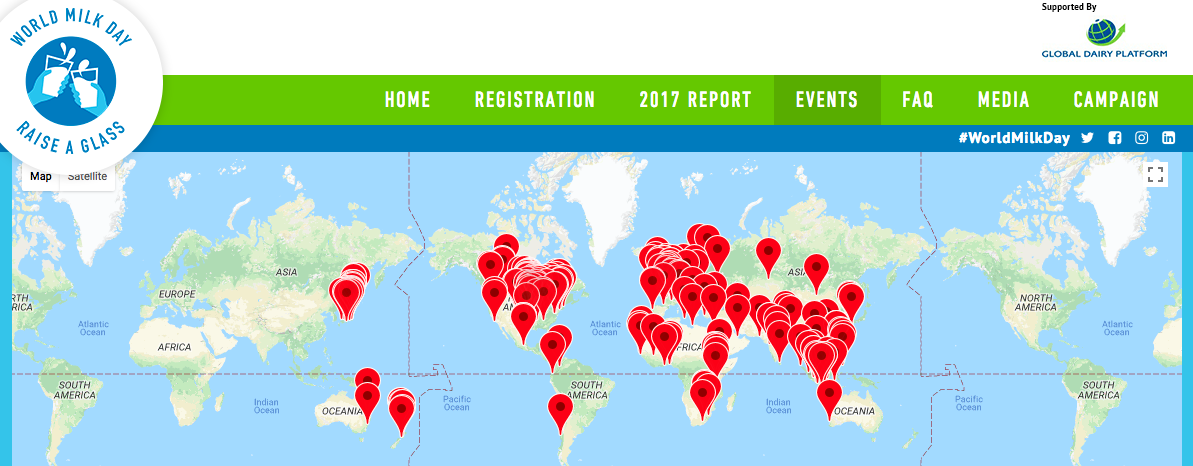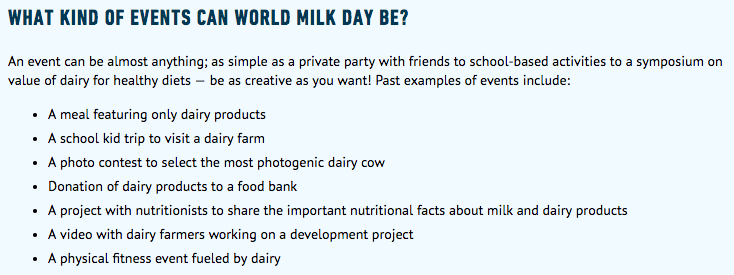
Disrupt World Milk Day
World Milk Day is upon us again, oh joy. World Milk Day (June 1) was founded in 2001, and since then the number of participating countries has been steadily growing. It was created and is supported by the dairy industry and the UN Food and Agriculture Organization to market milk to the masses because without cow’s milk, we wouldn’t be able to raise new generations of humans to adulthood.
Jk. Many of the cultures where milk is being pushed do not have a tradition of milk consumption, and they were doing quite alright before the dairy industry and their henchmen at the UN decided to push this food onto them through dumping and intense marketing.
The main nutritional selling point for milk is calcium and we are led to believe that no other food can provide it, but calcium is in fact plentiful in many plant-based foods across cultures. Off the top of our heads, here are some calcium-rich foods that are traditionally consumed in some areas where milk is not: greens, tofu, tortillas, seeds and nuts. Another selling point is protein, but protein is even more ubiquitous than calcium.
World Milk Day pushes the myth that milk is necessary for children’s growth and development, but there is no nutrient in milk that can not be easily obtained in other foods. The calcium and protein in milk are accompanied by Insulin-like Growth Factor (IGF-1) and bovine estrogen, which increase the risk of cancers of the reproductive system. Milk proteins and fats have been linked to weight gain, diabetes and cardiovascular disease. Milk also contains lactose, a sugar that is indigestible to people who are lactose intolerant… which is most people in the world.
Indeed, lactose tolerance only became a dominant trait in some populations that have a long history of dairying. To digest milk, we need an enzyme called lactase, and like other mammals, most humans stop producing lactase past the age of weaning. When lactose-intolerant people drink milk, they don’t only experience unpleasant digestive symptoms–their absorption of nutrients is also decreased. School milk programs are therefore particularly cruel, as they are purposefully implemented in populations where dairy is not yet part of the diet so as to shift their food cultures and create new markets for the dairy industry. Children are taught to value milk as a normative and necessary part of their diet, while their traditional sources of calcium are effectively devalued and erased.
Let’s flood this World Milk Day with the truth about milk. Use the hashtag #WorldMilkDay to post articles, graphics, pictures, facts, and experiences about the cost of dairy: to cows and their calves, to the environment, to our food systems and to our health. Disrupt the narrative that milk is in any way necessary for humans.

Above are suggestions on events and activities from the World Milk Day website. Here are some of our ideas:
- Show the world calves in crates and cows crying for their babies
- Photos of cows with mastitis
- Speak of the link between milk consumption and disease
- Nutritional comparisons between milk and calcium-rich plant-based foods
- A free community meal that showcases healthy and delicious plant-based foods
- Videos of your amazing plant-fueled workouts and fitness journeys
- A field trip to showcase the environmental damage of dairy farms
For generations, milk was marketed to Americans as Nature’s perfect food, but cow’s milk is only perfect for calves. There is nothing happy or sensical about taking calves from their mothers, stealing the food that nature perfected for them, and giving it to human children, thereby setting them up for a lifetime of dis-ease, all to bolster industry profits. Disrupt the misinformation and the happy marketing this #WorldMilkDay.
